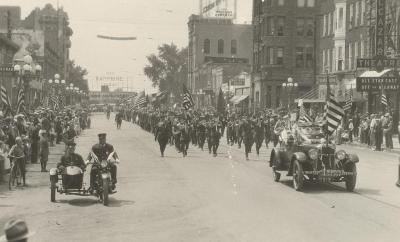About Historic Preservation in Great Falls
Authorized in 1935, the National Register of Historic Places was expanded under the National Historic Preservation Act of 1966 to become a planning device to guide federal, state and local actions. The 1980 amendments to the Act established the Certified Local Government (CLG) program, designed to expand the existing Federal-State preservation partnership to give local governments more of a role in the process. Section 106 of the Act directs Federal agencies to take into account the effects of projects on historic or archeological properties listed in or eligible for listing in the National Register of Historic Places (NR). Federally financed, assisted or licensed undertakings are required to determine whether historic resources are involved, evaluate the potential effect of the project and find ways to remove or minimize any adverse impact through consultation with the Advisory Council on Historic Preservation and the State Historic Preservation Office. The CLG program gives a local voice to the process of NR listing or determination of eligibility, as well as Section 106 Review, and provides preservation expertise for local planning and advice. The Act additionally requires State preservation programs to pass 10 percent of the State's annual appropriation from the Historic Preservation Fund to its CLGs.
In order to qualify for CLG status, the City of Great Falls and the Cascade County Commissions established a nine-member Historic Preservation Advisory Commission (HPAC) whose membership represents a high level of preservation, history and pre-history expertise. The primary purpose of HPAC is to advise the local governments on matters of preservation and to ensure that historic preservation is considered at all levels of City and County decision-making, and is incorporated in projects throughout the area.
While the program was codified as Chapter 2.40 of the City Code in 1990, Preservation Planning as a distinct function of the Planning Advisory Board did not begin until April of 2001. A half-time Historic Preservation Officer (HPO) was hired to administer the preservation program and act as staff to the HPAC. Before 2001, the Cascade County Historical Society Director acted as the local HPO.
The Historic Preservation Office maintains an inventory of identified National Register listed districts, sites, buildings and/or structures within Cascade County. This information is available to the public. Criteria for National Register listing and information on how to complete National Register nominations is also available.
Technical rehabilitation, preservation and restoration information is also available from the Historic Preservation Office to guide property owners in appropriate methods for maintaining the architectural integrity of historic properties.
The Historic Preservation Office also has brochures detailing Preservation Tax Incentives for Historic Buildings and applications; Historic Preservation Easement and Tax Abatement information; and maintains a list of some grants for preservation.
For more information contact the Planning & Community Development Office at 455-8550.

